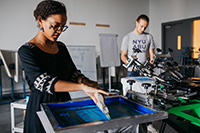Although NYU Abu Dhabi rising senior Nikolai Kozak (NYUAD '15) did not live through the dictatorship of Chile's Augusto Pinochet, the topic is not foreign to him — he grew up watching his father spend a big part of his life helping to free political prisoners in Chile.
Pinochet took power in a coup d’état on September 11, 1973, and ruled Chile as president until 1990. While the sense of dictatorship is present in his life, Kozak, like most of Chile's youth today, never truly understood it. "Despite the pain, it's a subject that newer generations are quick to forget or dismiss," he said.
Kozak believes that each generation has its own collective subconscious, which affects how they think and deal with political and social issues. "The generation that was born and lived through the military regime had a very different understanding of what political, social, and economic life is, versus those that were born after 1990 — like me," Kozak explained. And Kozak is keen to initiate a conversation with young people regarding the regime, its effects, and relevance today: "Although I was not born during the political dictatorship, I do live under the political systems that were created by the people who had lived under the regime."
Bridging social sciences with arts, Kozak created an innovative way to address the difficult and complex topic. Titled Memoria 35000, Kozak's art project is named after the 35,000 cases of human rights abuses that happened during the dictatorship.
From the rich archives found in the Documentation Center at the National Museum for Memory and Human Rights, Kozak picked 60 letters, reports of abuses, manuscripts, and notices of detention and execution that he "felt illustrated very powerfully what was going on at the time" and created drawings based on these documents. He also took out portions from the letters and displayed these excerpts on their own. Unattributed without an author or date, these fragments also "served as a poetic interpretation" of the past, Kozak explained.
Not stopping there, during a visit to Santiago, Chile, last summer, Kozak stenciled and wheatpasted phrases from the exhibition and drawings into anonymous pieces of street art. The project was a deeply introspective experience for Kozak, and his hard work paid off when the Museum for Memory and Human Rights wanted to exhibit his work.
Having his project exhibited at the museum had huge significance for Kozak. "This museum is one of the most controversial and important national museums in Chile because of what it represents for the entire country. It plays a central part in the Chilean cultural paradigm, and being involved in it was an amazing experience," Kozak explained.
Memoria 35000 is slated to be exhibited at the museum in September 2014, coinciding with the 41st anniversary of the coup.
This article originally appeared in NYUAD's 2013-14 Research Report (13MB PDF).


